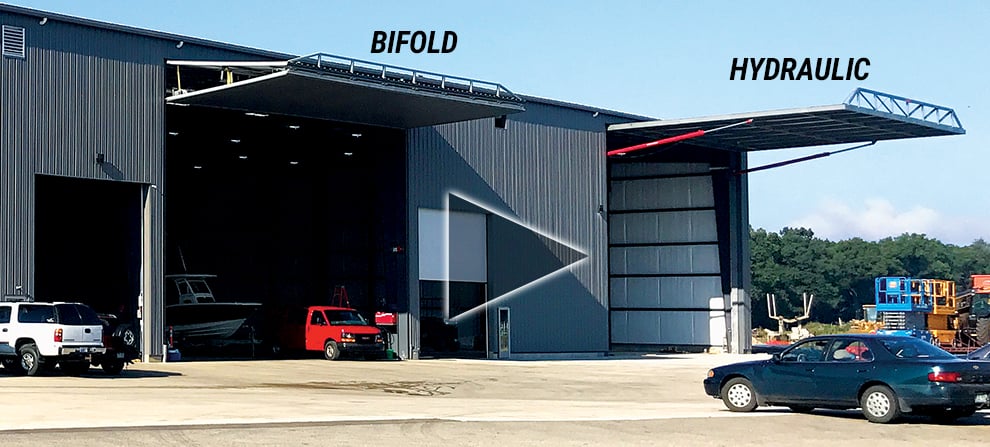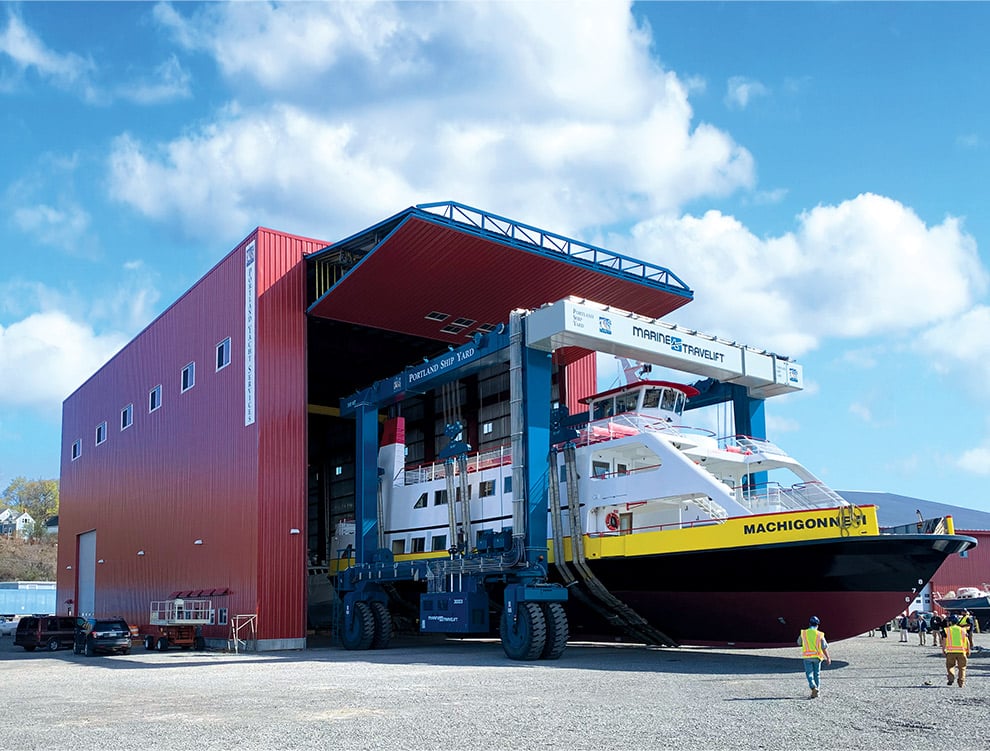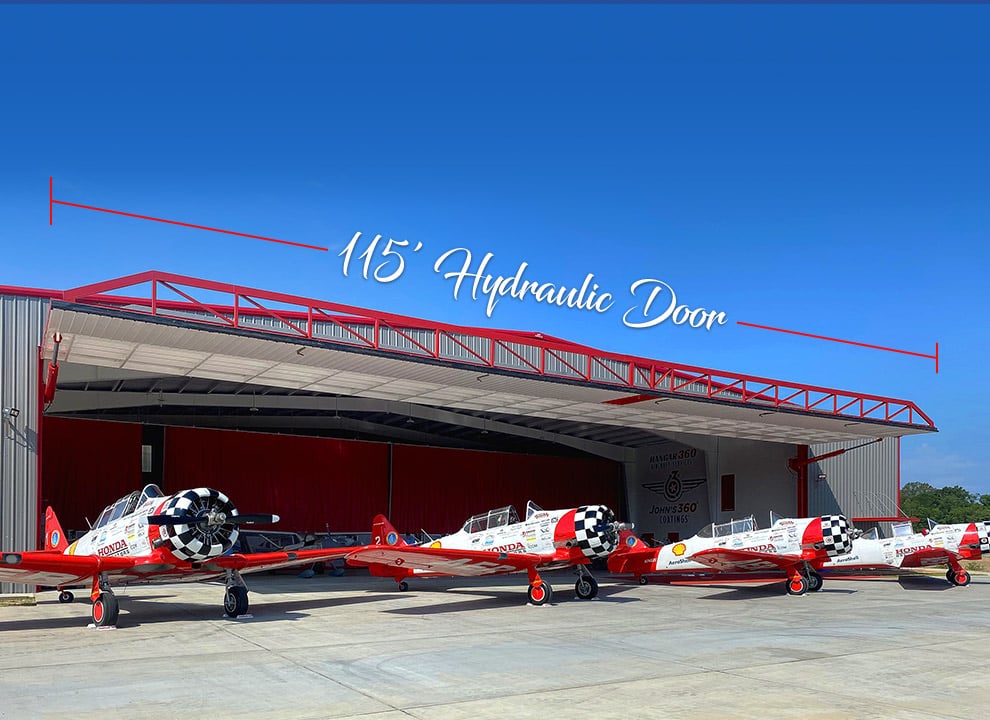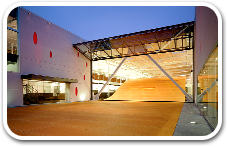CONTACT US

Lift Strap
Bifold Doors
| • Quieter | • Easy to install |
| • Safer | • Last longer |
| • Faster | • Easy to maintain |
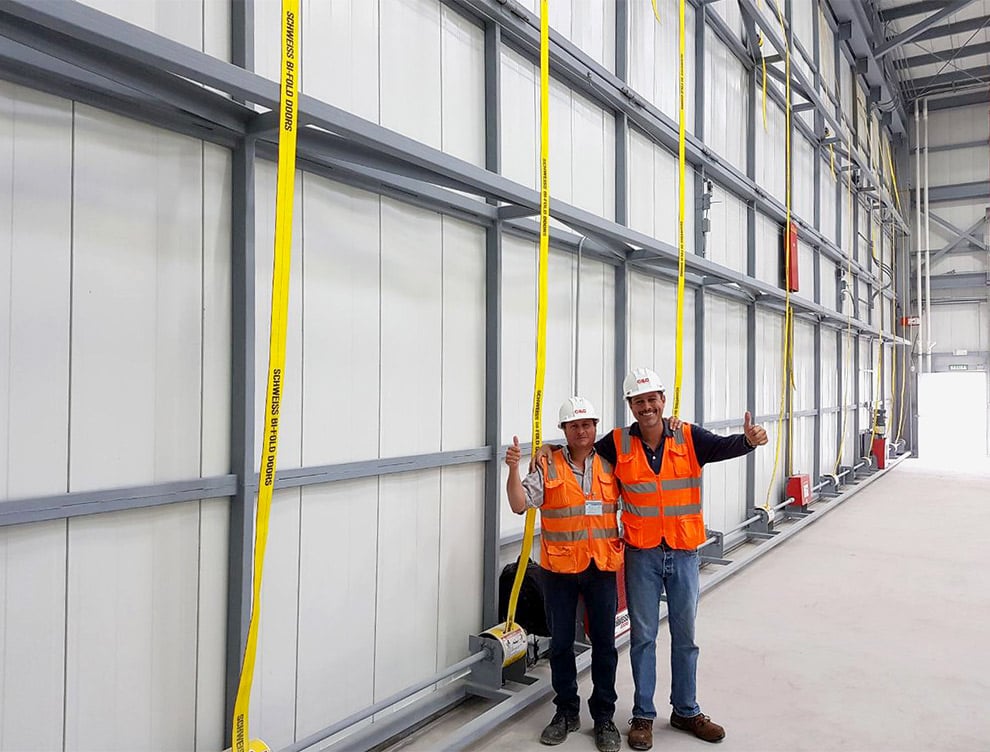
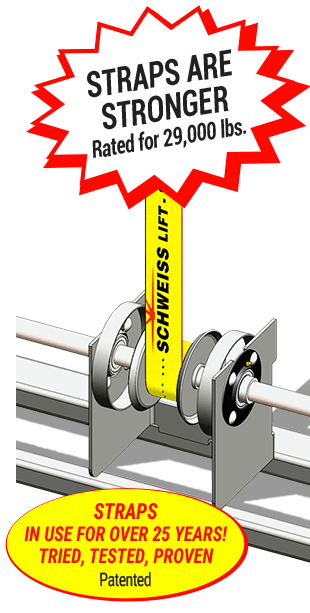
Lift Straps are better than outdated cables
Some manufacturers still continue to try and sell outdated cable lift bifold
doors - cables not only require frequent maintenance due to fraying,
overwrapping or strands breaking , but also only rated for 7,200 Lbs. each,
open much slower, are hard to adjust, are not as reliable as straps, and are
noisier than liftstrap doors. Straps are a better design!
Ninety-nine percent of Schweiss bifold door customers are now demanding the
stronger, patented polyester lift straps. For years, bifold doors were
lifted and lowered by the slow, conventional means of outdated steel
cables, that have a tendency to fray, overwrap, and break.
Lift straps are a thousand times better
than cables and easier to install!
Other manufacturers try to put their spin on cables, but the truth remains that cables are not easy to work with
and the life expectancy is shorter compared to lift-straps. Cables operate on a fixed speed, whereas straps lift
your door faster and are exceptionally much safer!

Automatic Strap Latches...
Straps Do the Latching
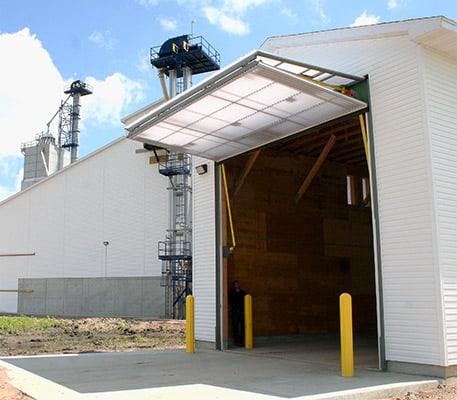
New clean / simple design!
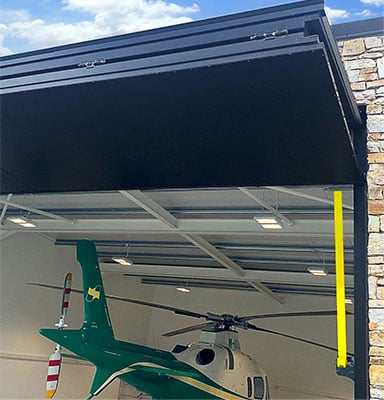
Strap Latches secure the door in the open position
Automatic Latch straps are a thousand times better and easier to install!
Straps Do The Latching!
• Firmly hold the door against your building in the closed position
• Adds protection from wind gusts in any position during operation
• Firmly locks the door to the building when closed
• Secures the door when opening
90% Less Moving Parts
• No more cables | • No more pulleys |
• No more chains | • No more sprockets |
• No Widgets | • No linkage rods to mess with |
• Quieter Operation | • No additional motors needed |
Patent Pending
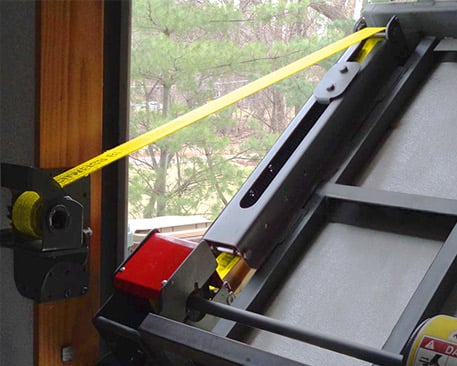
Strap Latch adds protection from wind gusts while operating
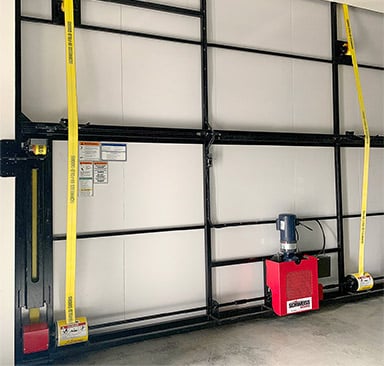
Strap Latches secure the door when closed
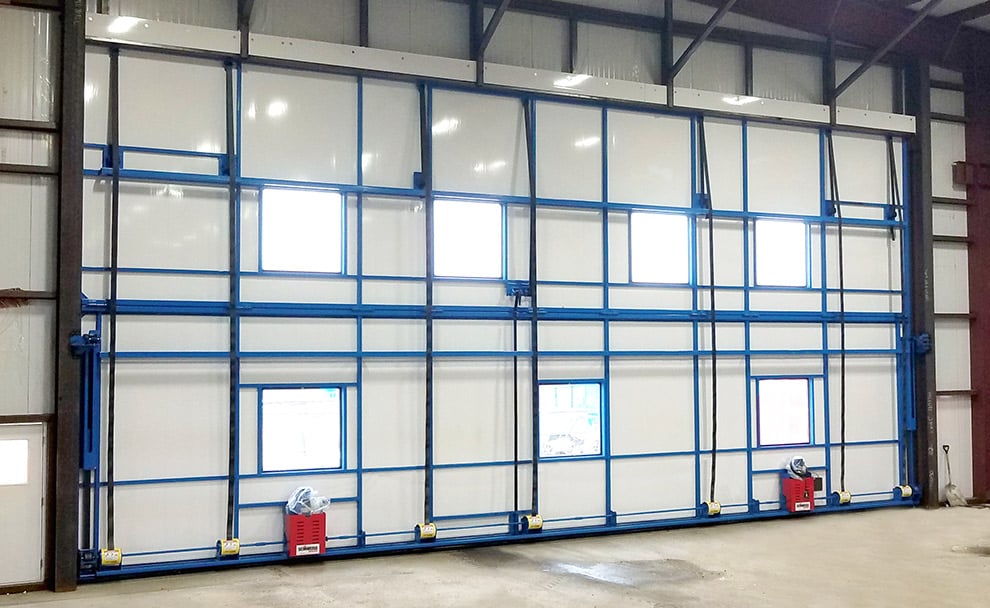
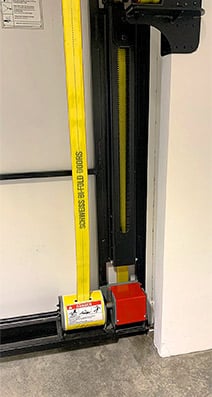
ADVANTAGES OF THE
AUTOMATIC STRAP LATCHES
This is what every door owner wants and needs. Unlike other latch mechanisms, the new design will firmly hold the door against your building in all positions; securing the door when open/partially open and will firmly lock the door when closed. It will offer added protection from wind gusts while the door is in any position during operation.
Straps Secures the door to the building
New clean / simple design!

All-Strap Door
The New Evolution of Bifold Doors
Patented
Bifold Doors have been around for years, but thanks to Schweiss Doors foresight, they are 1000 times better now! Calls are coming in from owners of all styles of cable doors wanting to convert to straps.
Patented Lift Straps & Strap Latches
Maintenance has dropped off to nothing with the Liftstraps and Latch Straps
• Liftstraps make the door easier to look over for potential problems
• Straps certainly require alot less maintenance
• Virtually no adjustment necessary with straps
• No more worries about cables fraying or cable clamps slipping
It doesn't get any better than an all-strap door
"Cable where just a maintenance nightmare. We were having a lot of problems keeping the cables adjusted and
replacing broken cables. It was really hard to tell when a cable was slipping, and it would go from looking
perfectly fine to fraying almost immediately."
CUSTOMERS ASK . . .
"Can you convert our outdated cable-lift doors
to the Schweiss liftstraps and autolatches?"
That's a good question! The answer is YES!
No matter the make, model or manufacturer of the door you own,
you can see the obvious: Schweiss Liftstrap Bifold doors are a safer,
faster, and better solution than outdated cable lift doors.
Strap Testimonials
"Schweiss can convert any
cable bifold door to a
'Lift Strap' bifold door"
"We were having some trouble
with frayed cables.
I'd recommend liftstraps to anyone."
"I do like the liftstraps.
They're a lot less maintenance,
faster and quieter."
"We also like the convenience
of the liftstraps being faster than
the old cables on our door."
"The straps run the door up
faster and safer and I like the
10-year guarantee."
"The decision to get liftstraps
on my bifold door was more of
a safety issue for me."
"We're having zero problems
now with the liftstraps."
"A lot of guys are coming to look at
our door. I'm sure you'll be selling
more Lift Straps, we like 'em!"
"I can't say enough about
your liftstraps, I wish I'd
done it originally."
Introducing Schweiss One-Piece
Hydraulic Doors
Quality like no other
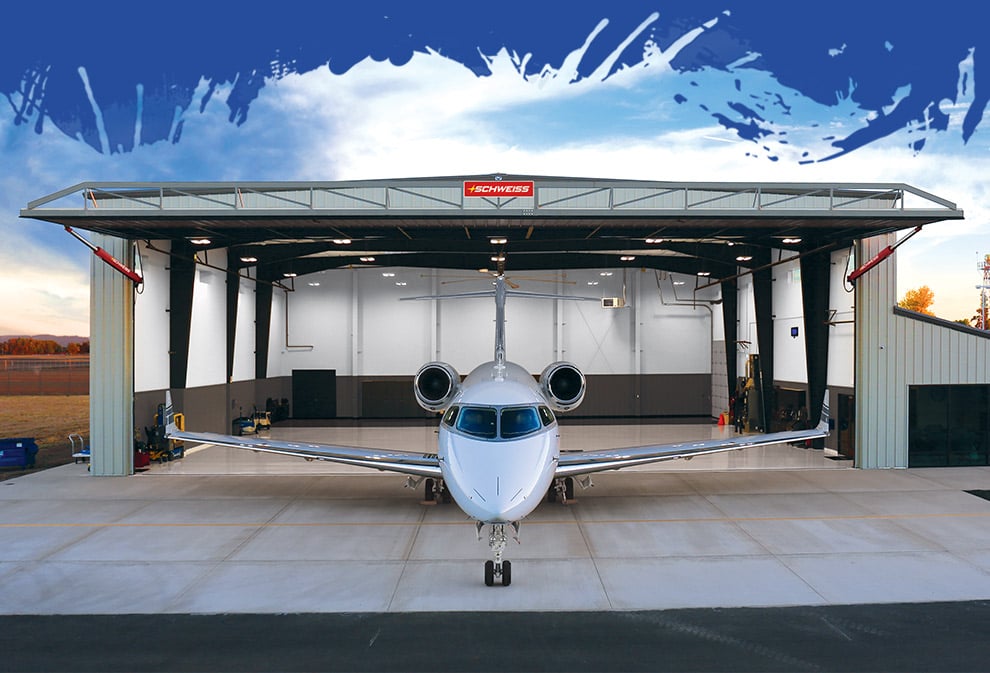
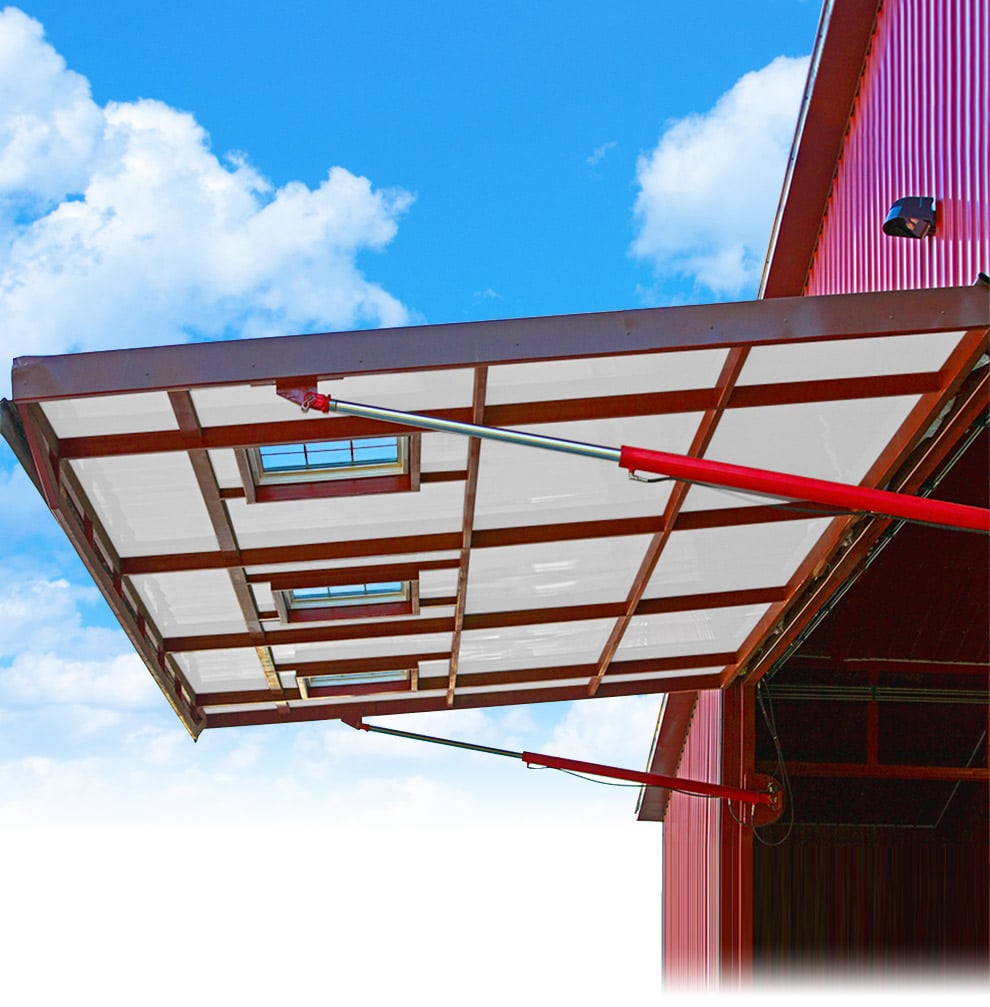
Big...Clean...
Beautiful
All-Steel
Hydraulic Doorframes
| • Door's subframe adds extra building support | |
| • Schweiss custom designs every door | |
| • Double push tubes | |
| • More hinges... Strong design... Better door |
Hydraulic Door Advantages
| • Faster Opening Speeds | • Less Headroom Required |
| • Quiet, Smooth Operation | • Easy To Install |
| • Bigger, better cylinders | • Low Maintenance Components |
| • Less Moving Parts |
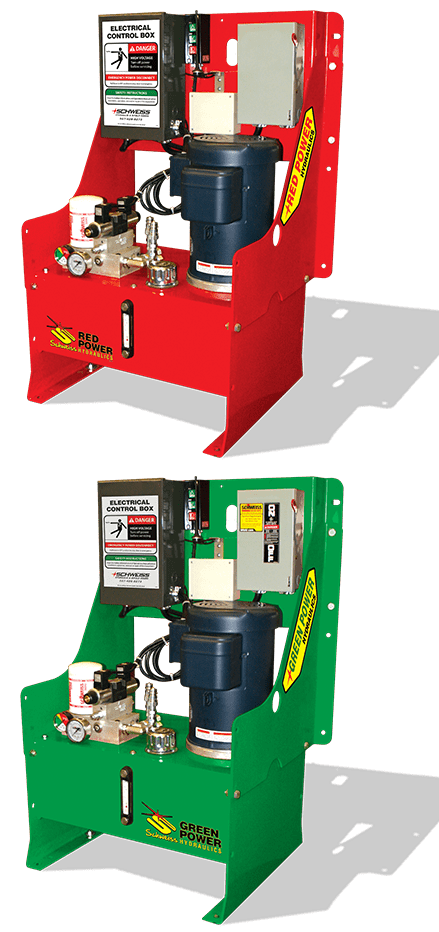
Schweiss Has a Unique, Compact
Hydraulic Pump Design
| • Remote Control Available | |
| • Complete Electrical Package | |
| • Emergency Backup Fittings | |
| • Oil Filter & Gauges | |
| • Clean Design |
Most Versatile Hydraulic
Pump on the Market
| • They're Powerful | |
| • They're Reliable | |
| • They're Quiet |
Mounting Options for the
Hydraulic Power Unit
- 1Under Workbench
- 2Stand Alone Unit
- 3Wall Mount
- 4Tractor Fittings ( included )
- 5Battery Backup ( optional )
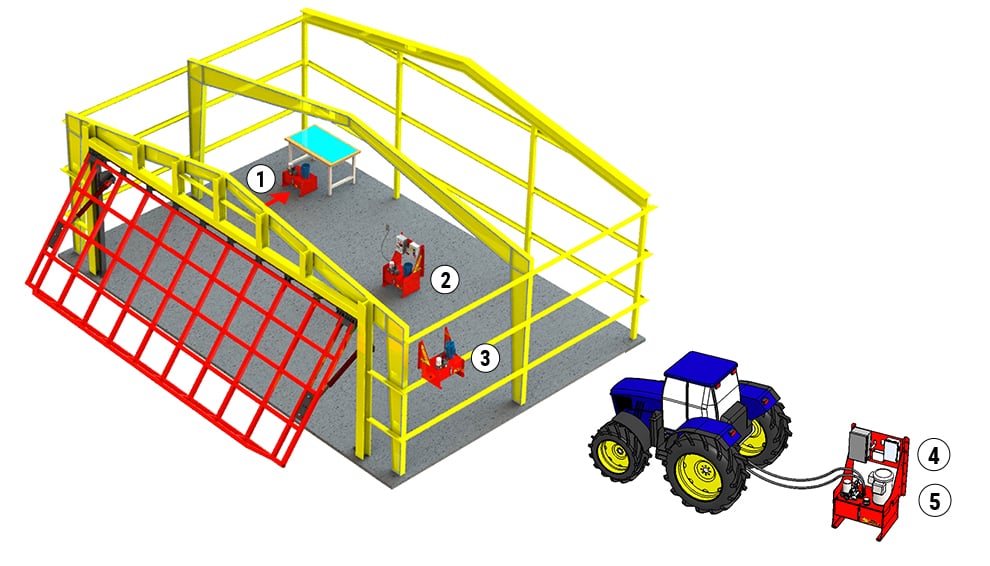

New
Hinge Design
Better, Stronger Hinges Sell the Door
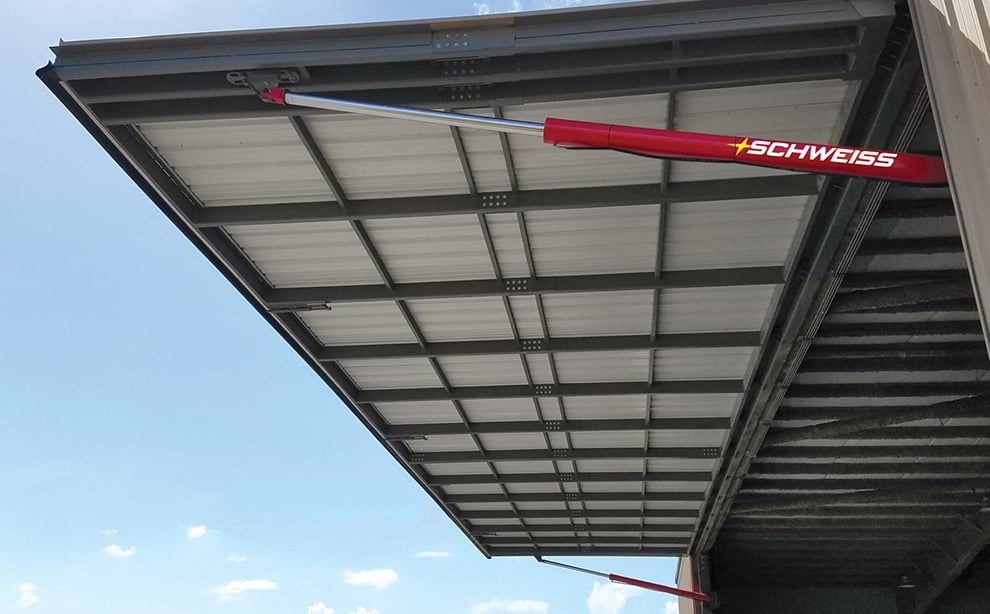
While other doors may
appear to be the same on
the surface, there is really . . .
no comparison !
The Schweiss Hydraulic Door Advantages
| • Greasable hinges on each and every hydraulic door. | |
| • Ability to grease the top hinges without removing the top rubber seal. | |
| • All steel doorframe members . . . No Wood ! | |
| • Quiet gear-driven hydraulic pumps and spherical bearings on each cylinder. |
"OUR NEW WRAP-AROUND HINGE
DESIGN SETS THE NEW STANDARD
FOR HYDRAULIC DOORS"
Nothing like it on the market

Must be strong
The door weight and hydraulic forces pull down on hinge when door is opening
Schweiss Hydraulic Hinges Provide Extra Support
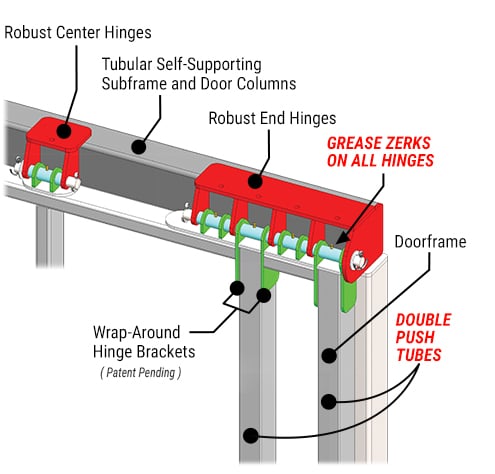
"There have been hydraulic doors with hinge welds that failed, literally tearing off the doorframe and destroying the door," Schweiss says. "Our design team provided a durable wrap-around hinge with grease zerks that are accessible without removing the top rubber seal."
Strongest Hinges on the Market!
Strong Doorframe!
Schweiss doorframes are designed with triple push tubes that are tied directly into the wrap-around hinges that connect each vertical push tube directly to the header tube. The advantage of triple push tubes is that forces of hydraulic cylinders are evenly distributed to the doorframe and the wrap-around hinges.

Strongest Doorframe on the Market!
What Customers are saying...
| • "The hinges sold me." | |
| • "The Schweiss team hit a home run by putting grease zerks in their hinges." | |
| • "Now that's a serious hinge, you guys have it figured out!" | |
| • "Oh my, nothing comes close to your hinges. Professionally done!" | |
| • "Nothing on the market that even comes close to the Schweiss hinge design." |
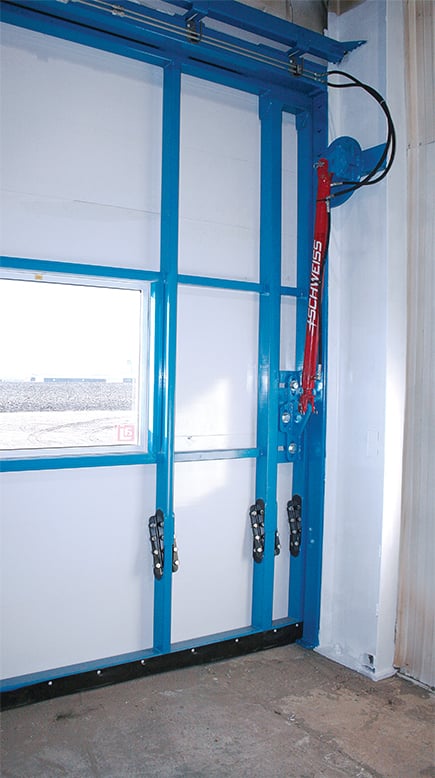
Schweiss is the only manufacturer to offer hinges that can be greased from underneath the door without removing the top weather seal.
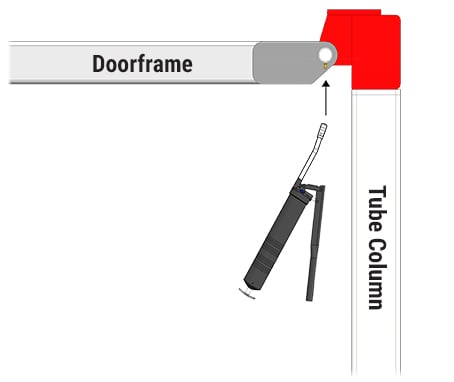
Grease Zerks
On All Hinges
Hinges can be greased
from underneath the door
Others try to get by
using bushings and
welding the hinge pins
in place . . . Not the Schweiss way!
"No one else in the industry
Offers these unique features"
This Schweiss hydraulic door was designed for 175 mph windload and equipped with a hydraulic 2-speed valve for smooth operation that includes a 12 volt backup system in case of a power outage. The door has the newly designed and patented wrap around hinges that can be lubricated from inside the building, making maintenance quick and easy!
Only available on Schweiss Doors . . .
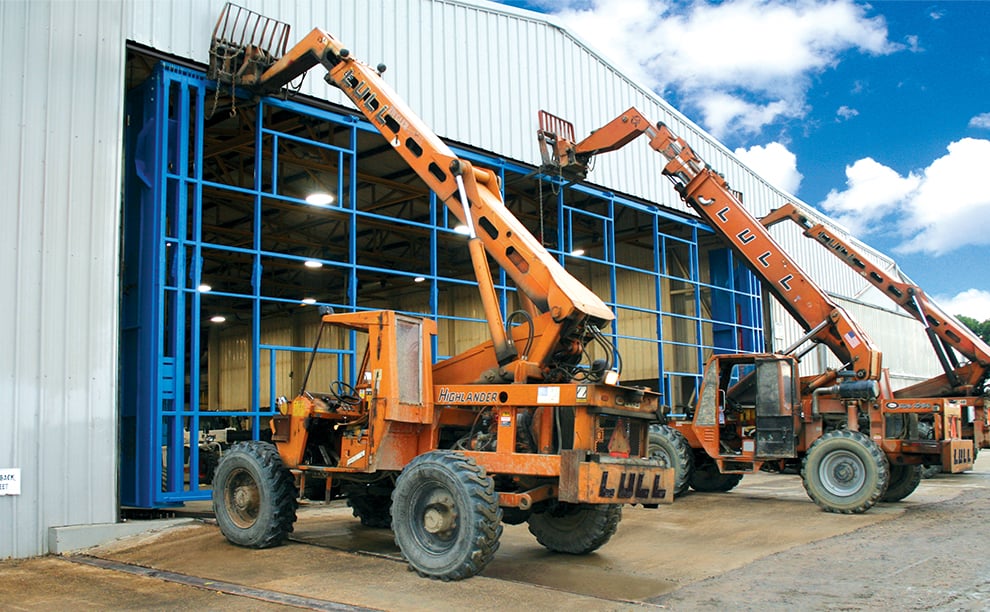

Spherical Bearings
Doors Are Always Moving and Flexing

Spherical Bearings are an
Important Feature To Have
Hydraulic doors are large in size and just like an airplane wing, the doorframe flexes during operation. The hydraulic cylinders on each side of the doorway are connected to the doorframe and the building using spherical bearings. The spherical bearings accommodate the flexibility of the doorframe while at the same time allowing the cylinders to raise and lower the door without binding on the hydraulic cylinder pins and brackets. Spherical Bearings on both ends of the cylinder allow the cylinders to stay straight through the full range of motion.
"No one else in the industry offers this unique feature" only available on Schweiss Doors...
SCHWEISS USES
LARGER CYLINDERS
Spherical Bearings Are a Smart Feature to Have!

Allows for Flexing
Stays Straight
Allows for Flexing
Allows for Flexing
Stays Straight
Allows for Flexing

New
Splice Connection
Makes Shipping and Assembly Easy
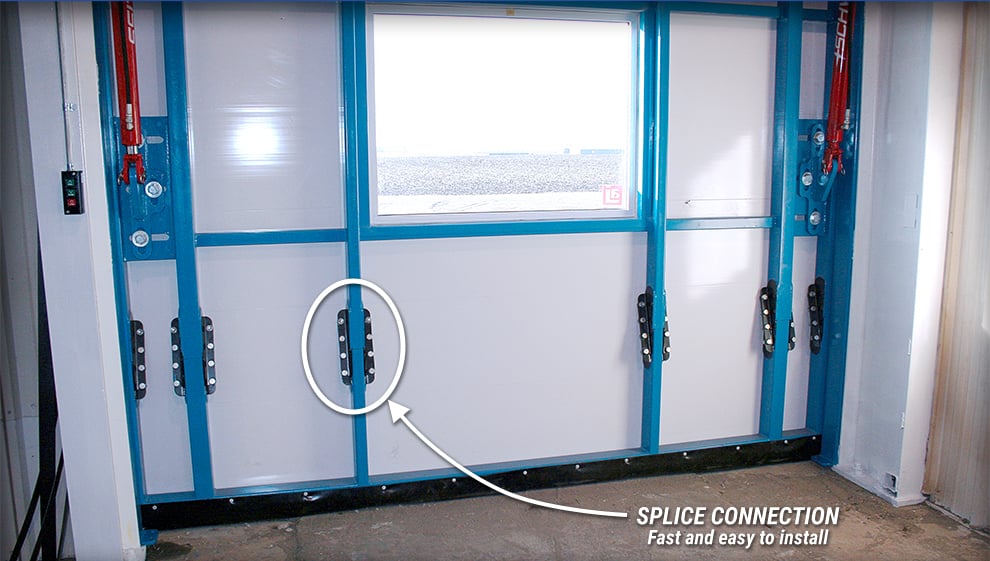
The doorframe sections are shipped on a standard size trailer saving shipping costs for any size door.
| • Sturdy connection | |
| • Easy assembly | |
| • Easy to install | |
| • Clean design |
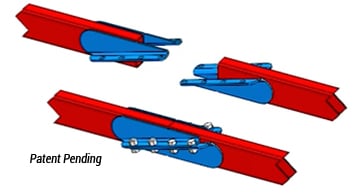
SEE VIDEO

Schweiss Doors
Splice Connection
Quickly and easily assembled before hanging the door in the opening.

Specializes in
Large Hydraulic Doors
For Large Buildings
Self-supporting subframe included on every doorframe
More clearance . . . Lose no headroom
Robust hinges with grease zerks
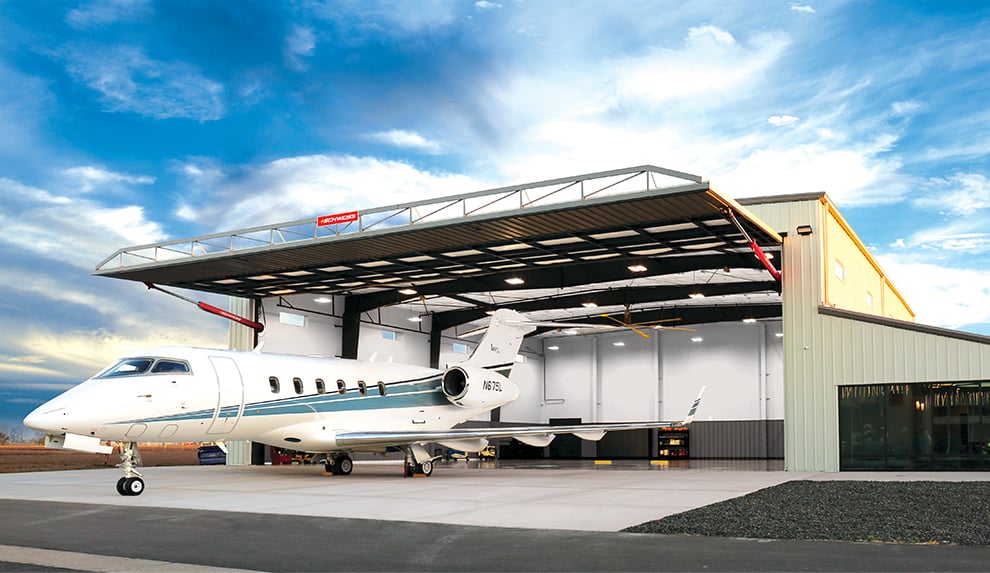
The Schweiss hydraulic door comes with its own self- supporting subframe for added strength and support. All models, come standard with double push tubes at each side of the door. Schweiss hydraulic doors are renowned for their heavy-duty hydraulic cylinders with spherical bearings to extend the life of the door. Schweiss doorframes also come standard with the new robust hinge design with easy to grease hinges.

A Common Question Customers Ask:

Schweiss Responds:
"The choice is yours. Each door offers something different. Each has specific advantages. Tell us your situation, so we can better advise you. The bottom line - it's the customers choice. Only Schweiss Doors gives you that advantage. Schweiss Doors already has a long history in the door world. We are the 1st choice of thousands of customers and our Hydraulic Doors are leading the way. With either door you get Schweiss Quality. Talk with us first and we can make your decision easier... Hydrauic or Bifold!
"We give you options so YOU can decide what is important to you."
